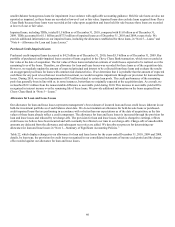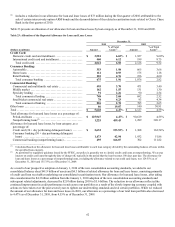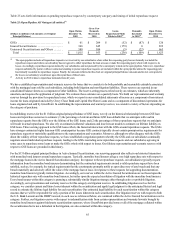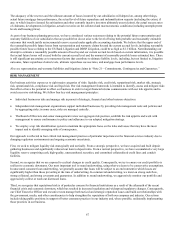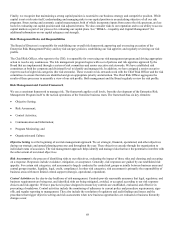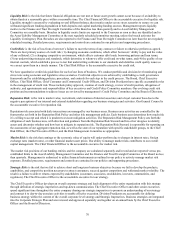Capital One 2010 Annual Report Download - page 90
Download and view the complete annual report
Please find page 90 of the 2010 Capital One annual report below. You can navigate through the pages in the report by either clicking on the pages listed below, or by using the keyword search tool below to find specific information within the annual report.70
Liquidity Risk: is the risk that future financial obligations are not met or future asset growth cannot occur because of an inability to
obtain funds at a reasonable price within a reasonable time. The Chief Financial Officer is the accountable executive for liquidity risk.
Liquidity strength is assessed by evaluating several different balance sheet metrics under severe stress scenarios to ensure we can
withstand significant funding degradation in both deposits and capital marketing funding sources. Management reports liquidity
metrics to the Finance and Trust Oversight Committee of the Board no less than quarterly and to Asset/Liability Management
Committee on a monthly basis. Breaches in liquidity metric limits are reported to the Treasurer as soon as they are identified and to
the Asset/Liability Management Committee at the next regularly scheduled committee meeting, unless the breach activates the
Liquidity Contingency Plan. Breaches are also reported to the Finance and Trust Oversight Committee no later than the next regularly
scheduled meeting. Detailed processes, requirements and controls are contained in our policies and supporting procedures.
Credit Risk: is the risk of loss from a borrower’s failure to meet the terms of any contract or failure to otherwise perform as agreed.
There are four primary sources of credit risk: (1) changing economic conditions, which affect borrowers’ ability to pay and the value
of any collateral; (2) a changing competitive environment, which affects customer debt loads, borrowing patterns and loan terms;
(3) our underwriting strategies and standards, which determine to whom we offer credit and on what terms; and (4) the quality of our
internal controls, which establish a process to test that underwriting conforms to our standards and identifies credit quality issues so
we can act upon them in a timely manner. The Chief Risk Officer is the accountable executive for credit risk.
We have quantitative credit risk guidelines for each of our lines of business. We conduct portfolio and decision level monitoring and
stress tests using economic and legislative stress scenarios. Credit risk objectives are achieved by establishing a credit governance
framework and by establishing policies, procedures, and controls for each step in the credit process. The Board, Chief Executive
Officer, Chief Risk Officer, Chief Consumer and Commercial Credit Officers, and Division Presidents have specific accountable roles
in the management of credit risk. These include policy approval, creation of credit strategy, review of credit position, delegation of
authority, and appointments and responsibilities of key executives and Credit Policy Committee members. Our evolving credit risk
position and recommendations to address issues are reviewed by management’s Credit Policy Committee and the Board of Directors.
Reputation Risk: is the risk to market value, recruitment, and retention of talented associates and a loyal customer base due to the
negative perceptions of our internal and external stakeholders regarding our business strategies and activities. Our General Counsel is
the accountable executive for reputation risk.
Reputation risk associated with daily interactions are managed by our business areas. Business area activities are controlled by the
frameworks set forth in the Reputation Risk Policy and other risk management policies. Each business area determines how much risk
it is willing to accept and when it is prudent to execute mitigation activities. The Reputation Risk Management Policy sets forth the
obligation of each business area, with direction and guidance from the Reputation Risk Steward and his or her designee to identify,
assess and determine whether and how best to mitigate its reputation risk. The Reputation Risk Steward is responsible for reporting on
the assessments of our aggregate reputation risk, as well as the state of our reputation with specific stakeholder groups, to the Chief
Risk Officer, the Chief Executive Officer, and the Risk Management Committee as appropriate.
Market Risk: is the risk that earnings or the economic value of equity will under-perform due to changes in interest rates, foreign
exchange rates (market rates), or other financial market asset prices. Our ability to manage market risks contributes to our overall
capital management. The Chief Financial Officer is the accountable executive for market risk.
The market risk positions of our banking entities and the company are calculated separately and in total and are reported versus pre-
established limits to the Asset/Liability Management Committee and the Finance and Trust Oversight Committee of the Board no less
than quarterly. Management is authorized to utilize financial instruments as outlined in our policy to actively manage market risk
exposure. Detailed processes, requirements and controls are contained in our policies and supporting procedures.
Strategic Risk: is the risk that we fail to achieve short and long-term business objectives because we fail to develop the products,
capabilities, and competitive position necessary to attract consumers, succeed against competitors and withstand market volatility. The
result is a failure to deliver returns expected by stakeholders (customers, associates, stockholders, investors, communities, and
regulators). The Chief Executive Officer is the accountable executive for our strategy.
The Chief Executive Officer develops an overall corporate strategy and leads alignment of the entire organization with this strategy
through definition of strategic imperatives and top-down communication. The Chief Executive Officer and other senior executives
spend significant time throughout the entire company sharing our strategic imperatives to promote an understanding of our strategy
and connect it to day-to-day associate activities to enable effective execution. Division Presidents are accountable for defining
business strategy within the context of the overall corporate level strategy and Strategic Imperatives. Business strategies are integrated
into the Corporate Strategic Plan and are reviewed and approved separately and together on an annual basis by the Chief Executive
Officer and the Board of Directors.


